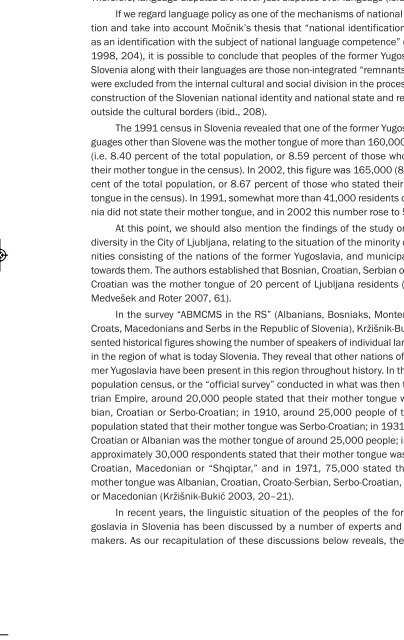The Scars of the Erasure_web
The Scars of the Erasure_web
The Scars of the Erasure_web
- No tags were found...
You also want an ePaper? Increase the reach of your titles
YUMPU automatically turns print PDFs into web optimized ePapers that Google loves.
<strong>Erasure</strong>_4a 10.1.11 20:29 Page 235THE ERASED LANGUAGE235upon minorities, it is never an enforcement <strong>of</strong> <strong>the</strong> language only, but also <strong>of</strong> politicaland cultural demands concerning <strong>the</strong> primacy <strong>of</strong> <strong>the</strong> state, <strong>the</strong> need forcommon rules and centralized institutions, <strong>the</strong> need to learn a new history andliterature and <strong>the</strong> need to constitute new nation-state loyalties and identities.<strong>The</strong>refore, language disputes are never just disputes over language (ibid.).If we regard language policy as one <strong>of</strong> <strong>the</strong> mechanisms <strong>of</strong> national integrationand take into account Močnik’s <strong>the</strong>sis that “national identification occursas an identification with <strong>the</strong> subject <strong>of</strong> national language competence” (Močnik1998, 204), it is possible to conclude that peoples <strong>of</strong> <strong>the</strong> former Yugoslavia inSlovenia along with <strong>the</strong>ir languages are those non-integrated “remnants” whichwere excluded from <strong>the</strong> internal cultural and social division in <strong>the</strong> process <strong>of</strong> <strong>the</strong>construction <strong>of</strong> <strong>the</strong> Slovenian national identity and national state and remainedoutside <strong>the</strong> cultural borders (ibid., 208).<strong>The</strong> 1991 census in Slovenia revealed that one <strong>of</strong> <strong>the</strong> former Yugoslav languageso<strong>the</strong>r than Slovene was <strong>the</strong> mo<strong>the</strong>r tongue <strong>of</strong> more than 160,000 people(i.e. 8.40 percent <strong>of</strong> <strong>the</strong> total population, or 8.59 percent <strong>of</strong> those who stated<strong>the</strong>ir mo<strong>the</strong>r tongue in <strong>the</strong> census). In 2002, this figure was 165,000 (8.44 percent<strong>of</strong> <strong>the</strong> total population, or 8.67 percent <strong>of</strong> those who stated <strong>the</strong>ir mo<strong>the</strong>rtongue in <strong>the</strong> census). In 1991, somewhat more than 41,000 residents <strong>of</strong> Sloveniadid not state <strong>the</strong>ir mo<strong>the</strong>r tongue, and in 2002 this number rose to 52,000.At this point, we should also mention <strong>the</strong> findings <strong>of</strong> <strong>the</strong> study on ethnicdiversity in <strong>the</strong> City <strong>of</strong> Ljubljana, relating to <strong>the</strong> situation <strong>of</strong> <strong>the</strong> minority communitiesconsisting <strong>of</strong> <strong>the</strong> nations <strong>of</strong> <strong>the</strong> former Yugoslavia, and municipal policytowards <strong>the</strong>m. <strong>The</strong> authors established that Bosnian, Croatian, Serbian or Serbo-Croatian was <strong>the</strong> mo<strong>the</strong>r tongue <strong>of</strong> 20 percent <strong>of</strong> Ljubljana residents (Komac,Medvešek and Roter 2007, 61).In <strong>the</strong> survey “ABMCMS in <strong>the</strong> RS” (Albanians, Bosniaks, Montenegrins,Croats, Macedonians and Serbs in <strong>the</strong> Republic <strong>of</strong> Slovenia), Kržišnik-Bukić presentedhistorical figures showing <strong>the</strong> number <strong>of</strong> speakers <strong>of</strong> individual languagesin <strong>the</strong> region <strong>of</strong> what is today Slovenia. <strong>The</strong>y reveal that o<strong>the</strong>r nations <strong>of</strong> <strong>the</strong> formerYugoslavia have been present in this region throughout history. In <strong>the</strong> 1846population census, or <strong>the</strong> “<strong>of</strong>ficial survey” conducted in what was <strong>the</strong>n <strong>the</strong> AustrianEmpire, around 20,000 people stated that <strong>the</strong>ir mo<strong>the</strong>r tongue was Serbian,Croatian or Serbo-Croatian; in 1910, around 25,000 people <strong>of</strong> <strong>the</strong> totalpopulation stated that <strong>the</strong>ir mo<strong>the</strong>r tongue was Serbo-Croatian; in 1931, Serbo-Croatian or Albanian was <strong>the</strong> mo<strong>the</strong>r tongue <strong>of</strong> around 25,000 people; in 1953,approximately 30,000 respondents stated that <strong>the</strong>ir mo<strong>the</strong>r tongue was Serbo-Croatian, Macedonian or “Shqiptar,” and in 1971, 75,000 stated that <strong>the</strong>irmo<strong>the</strong>r tongue was Albanian, Croatian, Croato-Serbian, Serbo-Croatian, Serbianor Macedonian (Kržišnik-Bukić 2003, 20–21).In recent years, <strong>the</strong> linguistic situation <strong>of</strong> <strong>the</strong> peoples <strong>of</strong> <strong>the</strong> former Yugoslaviain Slovenia has been discussed by a number <strong>of</strong> experts and opinionmakers. As our recapitulation <strong>of</strong> <strong>the</strong>se discussions below reveals, <strong>the</strong>re is no


